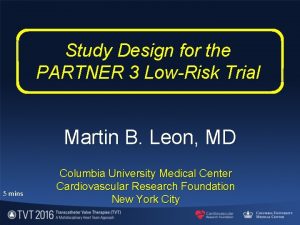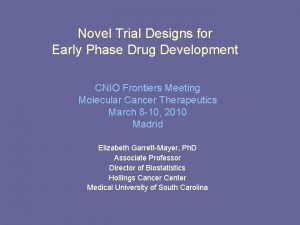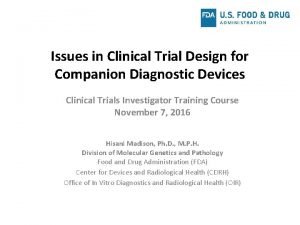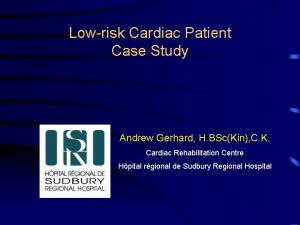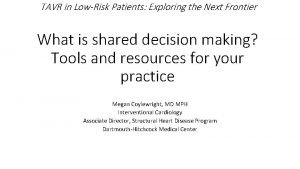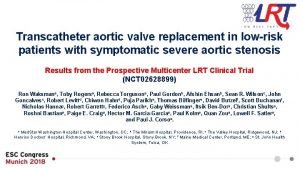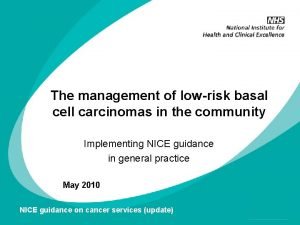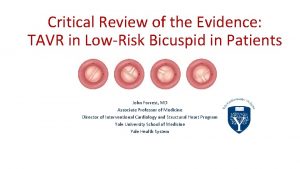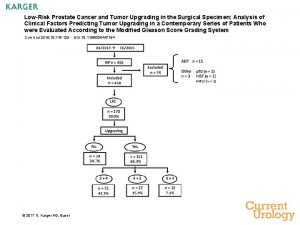Study Design for the PARTNER 3 LowRisk Trial













- Slides: 13

Study Design for the PARTNER 3 Low-Risk Trial Martin B. Leon, MD 5 mins Columbia University Medical Center Cardiovascular Research Foundation New York City

Disclosure Statement of Financial Interest TVT 2016, Chicago, IL; June 15 -18, 2016 Martin B. Leon, MD Within the past 12 months, I or my spouse/partner have had a financial interest/arrangement or affiliation with the organization(s) listed below. Affiliation / Financial Relationship Company • Grant / Research Support / SAB • Abbott, Boston Scientific, Edwards Lifescience, Medtronic • Consulting Fees / Honoraria • None • Shareholder / Equity • Claret, GDS, Mitralign, Valve Medical

TAVR in Low-Risk Patients • TAVR is now the dominant therapy in inoperable and high-risk AS patients; recent data shows clear benefits in intermediate-risk patients as well! • As complications continue to decline and the procedure is further simplified, there are clear secondary benefits associated with TAVR – reduced ICU and hospital LOS, more rapid QOL recovery, lower frequency of AKI, bleeding, and post-operative AF, and improved valve hemodynamics. • TAVR should now be introduced to low-risk AS patients in thoughtful randomized clinical trials!

The PARTNER 3 Trial Study Design Symptomatic Severe Calcific Aortic Stenosis Low Risk ASSESSMENT by Heart Team (STS < 4%, TF only) 1: 1 Randomization (n=1228) TF - TAVR (SAPIEN 3) Surgery (Bioprosthetic Valve) CT Imaging Sub-Study (n=200) Actigraphy/Qo. L Sub-Study (n=200) PRIMARY ENDPOINT: Composite of all-cause mortality, all strokes, or re-hospitalization at 1 year post-procedure Follow-up: 30 days, 6 mos, 1 year and annually through 10 years PARTNER 3 Registries Alternative Access (n=100) (TA/TAo/Subclavian) Bicuspid Valves (n=100) Vi. V (AV and MV) (n=100)

The PARTNER 3 Trial Key Inclusion Criteria • Severe, calcific aortic stenosis Ø AVA ≤ 1. 0 cm 2 or AVA index ≤ 0. 6 cm 2/m 2 Ø Mean gradient ≥ 40 mm. Hg or jet velocity ≥ 4. 0 m/sec • Symptom status Ø NYHA Functional Class ≥ 2, or Ø Exercise test with reduced exercise capacity, abnormal BP response, or arrhythmias, or Ø Asymptomatic with LVEF < 50% • Heart Team agrees patient is low operative risk and STS < 4% • Informed consent in all patients

The PARTNER 3 Trial Key Exclusion Criteria (1) • Aortic annulus size suitable for Sapien 3 valves (20, 23, 26, and 29 mm; CT annulus area 270 cm 2 – 680 cm 2) • Iliofemoral vessels without sufficient size and morphology (esp. Ca+) suitable for appropriate sheaths (TF only) • Bicuspid aortic valve • Severe AR (> 3+) or MR (> 3+) • LVEF < 30% • Complex CAD requiring revascularization (unprotected LMCA, Syntax score > 32, or Heart Team assessment that optimal revascularization cannot be performed) • CKD – e. GFR < 30 ml/min

The PARTNER 3 Trial Key Exclusion Criteria (2) • MI within 30 days, stroke/TIA within 90 days • Severe lung disease (FEV 1 < 50% predicted) or home oxygen • Significant frailty as determined by the Heart Team (after objective assessments) • Hemodynamic or respiratory instability requiring inotropic support or mechanical ventilation within 30 days

The PARTNER 3 Trial Primary Endpoint Safety and Effectiveness • Composite (non-hierarchical) of death (all-cause), strokes (all) or rehospitalization (valve-related or procedure-related and including heart failure) at 1 -year post-procedure • Assumptions: Ø Event rate for surgery 16. 6% and TAVR 14. 6% Ø One-sided alpha 0. 025 and relative non-inferiority margin 0. 35 Ø For 85% power, sample size 1, 068 patients Ø Due to event rate uncertainty, sample size increased 15% = 1, 228 patients Ø Primary analysis population = as-treated patients

The PARTNER 3 Trial Key Secondary Endpoints • Death (all-cause and CV) at 30 days and 1 -year • Strokes (with and without disability) at 30 days and 1 -year • Death (all) or strokes (all) at 30 days and 1 -year • Death (all) or strokes with disability at 30 days and 1 -year • Rehospitalization at 30 days and 1 -year • Vascular complications, bleeding, AKI, new-onset AF, new permanent pacemakers • Six-minute walk distance, QOL assessment (KCCQ scores), and NYHA Functional Class at 30 days and 1 -year • Length of stay (ICU and hospitalization) and days alive outof-hospital

The PARTNER 3 Trial Substudies and Registries (1) • CT sub-study (leaflet thickening/mobility/thrombosis) Ø 400 evaluable randomized patients (1: 1 TAVR vs. surgery) from ~20 centers with required time-resolved 3 D-MDCT imaging capabilities Ø Studies at 1 month and 1 year Ø Exclude patients with oral AC therapy • Actigraphy/QOL sub-study (cw KCCQ and 6 MWT) Ø 200 -400 evaluable randomized patients (1: 1 TAVR vs. surgery) from ~20 centers Ø Wearable actigraphy monitors at baseline and for 4 -8 weeks post-procedure

The PARTNER 3 Trial Substudies and Registries (2) • Alternative access registry Ø 100 low-risk patients with unfavorable TF access Ø Treated by TA, direct Ao, or other access routes (e. g. subclavian, carotid) • Bicuspid AS registry Ø 100 patients with severe AS and bicuspid AV disease from ~25 centers Ø TF only, “favorable” anatomy for TAVR, all risk categories • Sapien 3 Aortic and Mitral Valve-in-Valve registry Ø 150 patients; 75 aortic and 75 mitral with bioprosthetic valve failure from ~25 centers (all risk categories)

The PARTNER 3 Trial Special Considerations • Up to 60 study sites (U. S. and Canada) • 10 -year FU for all randomized patients (valve durability echocardiography assessments) • Young age not an exclusion criteria • Careful neurology evaluations to ascertain stroke endpoints • In patients with concomitant CAD, revascularization based on Heart Team assessment (within protocol guidelines) • CTAs in all patients; optimal valve sizing for both TAVR and surgery patients • Case review calls to adjudicate clinical and anatomic entry criteria

The PARTNER 3 Trial Summary • “Real World” low-risk AS study population – few exclusions • Rigorous trial design with meaningful 1 ry endpoint and numerous important 2 ry endpoints (including QOL and health economics) – VARC II and III definitions • Politically more challenging (surgeons “sweet spot”), so can’t predict enrollment cadence • 10 -year FU to address valve durability issues • Important substudies and registries – serial CTAs (valve leaflet thickening/motion), actigraphy wearables (new QOL methods), bicuspid valve disease, and aortic/mitral Vi. V
 Partner 3 study
Partner 3 study Vcaa visual communication design
Vcaa visual communication design Novel clinical drug trial design
Novel clinical drug trial design Ivd clinical trial design
Ivd clinical trial design Fspos
Fspos Typiska drag för en novell
Typiska drag för en novell Tack för att ni lyssnade bild
Tack för att ni lyssnade bild Vad står k.r.å.k.a.n för
Vad står k.r.å.k.a.n för Shingelfrisyren
Shingelfrisyren En lathund för arbete med kontinuitetshantering
En lathund för arbete med kontinuitetshantering Adressändring ideell förening
Adressändring ideell förening Personlig tidbok fylla i
Personlig tidbok fylla i Anatomi organ reproduksi
Anatomi organ reproduksi Densitet vatten
Densitet vatten
